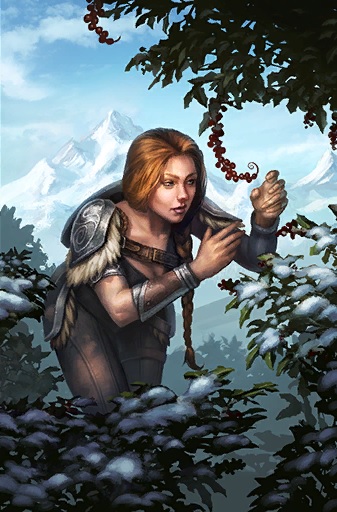Difference between revisions of "Woodland Foraging (sage ability)"
Tao alexis (talk | contribs) |
Tao alexis (talk | contribs) |
||
| Line 16: | Line 16: | ||
|} | |} | ||
| − | The '''Foraging Table''' is | + | The '''Foraging Table''' is systematically organized based on geographical range and the time of year. When a chance is specified, denoted by phrases such as "1 in 6," it signifies the likelihood of discovering only '''1d4''' pounds of food. Conversely, when a roll is indicated using "d" for die, for example, 3d4, it means that you should roll that number of dice to determine the pounds of food you find. |
| − | + | The provided dates are tailored for the northern hemisphere, and these should be reversed when considering the temperate and subpolar regions in the southern hemisphere. In polar regions, which are regarded as sub-polar during the summer months, specifically from May 8th to October 15th, foraging opportunities abound. However, for the rest of the year, foraging becomes impractical. | |
| − | + | It's essential to differentiate woodland foraging from [[Hunting (sage ability)|hunting]] or [[Catch Fishing (sage ability)|catch fishing]] techniques, as it doesn't involve the use of weapons or fishing lines. While fish may be captured using traps or nets in streams, foragers do not have the luxury of selecting their preferred type of food. They must make do with whatever sustenance nature provides. | |
| − | + | During certain periods of the year, it is feasible to gather a substantial amount of forage within a single day. However, it's crucial for characters to recognize that foraging is labor-intensive, and they are susceptible to the adverse effects of [[Heat Stroke|heat]] and [[Dehydration|dehydration]]. Consequently, there are instances when it's advisable not to forage all day, as collecting more food than necessary, especially when it's abundant, may not be the wisest choice. | |
Revision as of 05:50, 2 October 2023
Woodland foraging is an amateur-status sage ability in the study of Forester, similar to general foraging but more effective in temperate and subpolar forest ranges. The ability allows the search for naturally occurring food, including mosses and lichens, berries, wild grasses, herbs, nuts, acorns and fruits. The amount found is far more than an unskilled person might glean while looking over the same tract of land.
Contents
The time spent foraging equals 10 hours, though characters may forage for only 1-hour periods, in which case the found food is divided by the 10-hour standard. For example, Makran decides to forage for three hours; he rolls the total amount that would have occurred had he foraged for 10 hours, and recieves 3/10ths of that amount.
Foraging Table
| Latitude | Range | Nov 8 to Apr 14 | Apr 15 to 21 | Apr 22 to 30 | May 1 to 11 | May 12 to 24 | May 25 to Sep 7 | Sep 8 to 30 | Oct 1 to 15 | |
|---|---|---|---|---|---|---|---|---|---|---|
| taiga | 1 in 6 | 2 in 6 | 4 in 6 | 1d4 | 2d4 | 3d4 | 2d4 | 1d6 | 5 in 6 | |
| Range | Dec 11 to Feb 15 | Feb 16 to Mar 7 | Mar 8 to 31 | Apr 1 to 21 | Apr 22 to May 7 | May 8 to Oct 15 | Oct 16 to 29 | Oct 30 to Nov 12 | Nov 13 to 26 | Nov 27 to Dec 10 |
| woodland | 3 in 6 | 1d4 | 3d4 | 3d8 | 5d8 | 7d6 | 8d4 | 6d4 | 4d4 | 2d4 |
The Foraging Table is systematically organized based on geographical range and the time of year. When a chance is specified, denoted by phrases such as "1 in 6," it signifies the likelihood of discovering only 1d4 pounds of food. Conversely, when a roll is indicated using "d" for die, for example, 3d4, it means that you should roll that number of dice to determine the pounds of food you find.
The provided dates are tailored for the northern hemisphere, and these should be reversed when considering the temperate and subpolar regions in the southern hemisphere. In polar regions, which are regarded as sub-polar during the summer months, specifically from May 8th to October 15th, foraging opportunities abound. However, for the rest of the year, foraging becomes impractical.
It's essential to differentiate woodland foraging from hunting or catch fishing techniques, as it doesn't involve the use of weapons or fishing lines. While fish may be captured using traps or nets in streams, foragers do not have the luxury of selecting their preferred type of food. They must make do with whatever sustenance nature provides.
During certain periods of the year, it is feasible to gather a substantial amount of forage within a single day. However, it's crucial for characters to recognize that foraging is labor-intensive, and they are susceptible to the adverse effects of heat and dehydration. Consequently, there are instances when it's advisable not to forage all day, as collecting more food than necessary, especially when it's abundant, may not be the wisest choice.
